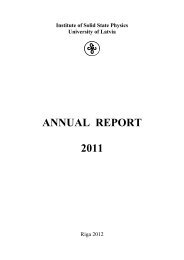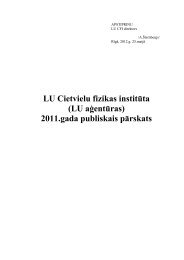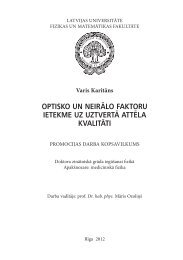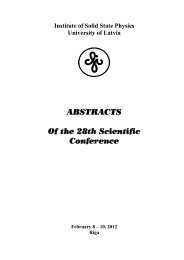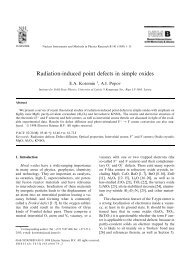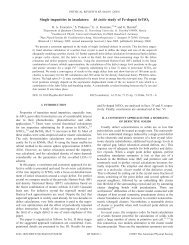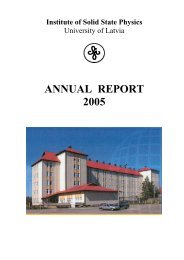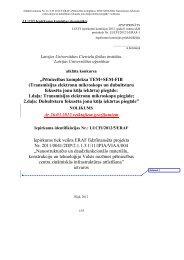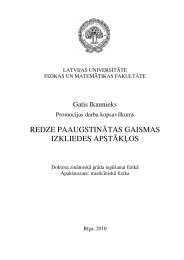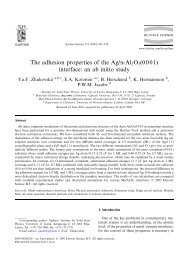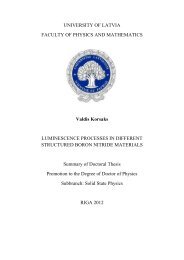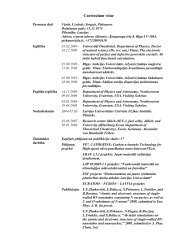Annual Report 2012 - Latvijas Universitātes Cietvielu fizikas institūts
Annual Report 2012 - Latvijas Universitātes Cietvielu fizikas institūts
Annual Report 2012 - Latvijas Universitātes Cietvielu fizikas institūts
Create successful ePaper yourself
Turn your PDF publications into a flip-book with our unique Google optimized e-Paper software.
and O atom incorporation therein at the two densely-packed surfaces and tilt grain<br />
boundaries are compared.<br />
Fig. 13. The slab models for the UN (001) (a) and<br />
(110) (b) surfaces (only the two outermost layers<br />
are shown).<br />
Fig. 14. The cross-section of the<br />
(310)[001](36.8°) tilt GB supercell<br />
[29] (15.40 Å × 4.87 Å × 34.13 Å<br />
with the oxygen atom incorporated<br />
into one of three possible positions.<br />
vac<br />
The formation energies E N_ form<br />
of N vacancy at 0 K inside the GB are equal with 3.3-3.5<br />
vac<br />
eV. These values are comparable with analogous values for E N_ form<br />
on UN (001) (3.6-3.7<br />
eV) and (110) (2.9-3.1 eV) surface and are smaller than those in the bulk material (~4.4<br />
eV) or in (001) or (110) slabs central layer (4.3-4.6 eV). It indicates a clear trend for<br />
segregation of vacancies towards the grain boundaries.<br />
The standard Gibbs free formation energy as a function of temperature is plotted<br />
in fig. 15 for the two UN surfaces and grain boundary. The difference in the standard<br />
N<br />
Gibbs free formation energy Δ G F<br />
between the (001) and (110) surfaces is considerable,<br />
N<br />
0.7 eV (fig. 15) and, most importantly, Δ G F<br />
decreases by 0.4 eV as the temperature<br />
increases from 400 to 700 K. The formation energy at the GB lies in-between that for the<br />
O<br />
two surfaces. Incorporation energy Δ G I<br />
negative values means that the reaction is<br />
exothermic and thermodynamically favorable. It increases with temperature by ~0.4 eV<br />
in the temperature range from 400 to 700 K but remains still negative (process<br />
energetically favorable).<br />
400 450 500 550 600 650 700<br />
3.8<br />
-5.6<br />
3.6<br />
3.4<br />
-5.8<br />
3.2<br />
3.0<br />
2.8<br />
(001)<br />
(110)<br />
GB<br />
-6.0<br />
-6.2<br />
2.6<br />
-6.4<br />
400 450 500 550 600 650 700<br />
66<br />
T, K<br />
Fig. 15. The standard Gibbs free formation energy of N vacancy (black curves) and<br />
the incorporation energy of O atom into the surface N vacancy (red curves) as a<br />
function of temperature for the (001), (110) surfaces and GB (position 2 in Fig. 14).<br />
The supercell size and slab thickness are 3×3 and 7 planes, respectively.



